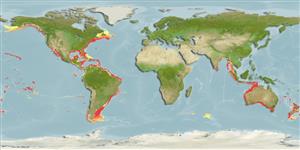Common names from other countries
Classification / Names / Names
Common names | Synonyms | Catalog of Fishes (gen., sp.) | ITIS | CoL | WoRMS
Environment: milieu / climate zone / depth range / distribution range
Ecology
Sessile; brackish; depth range 0 - 458 m (Ref. 116013). Subtropical
Atlantic and Pacific Oceans. Subtropical and tropical.
Length at first maturity / Size / Weight / Age
Maturity: Lm ? range ? - ? cm
Colonial (Ref. 19). Known from mangroves (Ref. 86642), exposed areas of bays, including any ledges at their entrance, shallow reefs, deeper coastal substrates (25- 100m) of the offshore fore-reef slope, Banks and upper slope (> 100m), tops of Challenger and Argus seamounts (Ref. 86643).
Life cycle and mating behavior
Maturity | Reproduction | Spawning | Eggs | Fecundity | Larvae
Reproduction occurs only in hydroid stage (Ref. 1663, p. 21).
Cairns, S.D., D.R. Calder, A. Brinckmann-Voss, C.B. Castro, D.G. Fautin, P.R. Pugh, C.E. Mills, W.C. Jaap, M.N. Arai, S.H.D. Haddock and D.M. Opresko. 2003. (Ref. 1663)
IUCN Red List Status (Ref. 130435)
CITES status (Ref. 108899)
Not Evaluated
Not Evaluated
Human uses
| FishSource |
Tools
More information
Age/Size
Growth
Length-weight
Length-length
Morphology
Larvae
Abundance
Internet sources
Estimates based on models
Preferred temperature
(Ref.
115969): 5.9 - 27.6, mean 17.4 (based on 561 cells).
Price category
Unknown.
